Since 1948, and continuing until around 1990, Canadian Inuit produced a body of art of extraordinary variety and quality – a phenomenon that I now refer to as the Classic Period of Inuit art. (Many of the forces at work continue today.) Although I am now primarily an art historian, my first experience was as a collector who found these works in stone, bone, antler and ivory irresistible. Subsequent study revealed, most interestingly, that similar modes of expression employed by one community of artists differed from that of artists in other communities or regions. What I refer to as a “community aesthetic” prevailed. In contrast to the flamboyant, almost baroque, sculpture from Baffin Island communities, the carefully crafted, highly naturalistic art from Nunavik (Northern Québec), or the fantastic whalebone carving from the Kitikmeot, much of the sculpture from the Keewatin (Kivalliq) Region, with its emphasis on form and line, appears decidedly minimal.
Perhaps, due in part to the severity of the traditional existence of the inland dwelling Caribou Inuit, much Keewatin sculpture is an expression stripped of details and reduced to essentials. The grey stone works are restrained and self-contained, consistent with the often hard, unyielding nature of the stone, a determinant of the simplicity of form as the stone itself could not easily be altered or detailed. (This is in great contrast to the soft steatite from Northern Québec, for example.) Images are rendered in a semi-representational non-narrative manner often resulting in near abstraction. Andy Miki (Lots 6 and 134) and John Pangnark (Lots 18, 82, and 135) from Arviat employed the simplest of shapes to create pure and exquisite form. The pioneer Inuit art expert George Swinton saw, in their outward appearance at least, similarities to Modern European sculpture. The sculpture of the Rankin Inlet artist John Tiktak (Lots 119 and 164), with its strong organic sense and sophisticated use of negative space, has drawn comparisons to Henry Moore (who owned a sculpture by Tiktak).
The intensity of the harsh but rewarding life experienced on the land appears reflected in the sculpture of another Rankin Inlet sculptor, John Kavik (Lot 45). His method was to energetically saw, file and drill until we are left with an intense work of art which nevertheless remains self-contained, even monumental. The gaunt “primitive” nature of Kavik’s work is also found with work by Elizabeth Nutaraluk from Arviat (Lot 69).
George Tatanniq uses the hard dark Baker Lake stone to produce elegant imposing pieces, often of the muskox (Lot 165). Rather than creating an interplay of broad volumes found in the work of such greats as Barnabas Arnasungaaq, Peter Sevoga, and Matthew Aqigaaq, Tatanniq further refines his shapes to produce majestic works with clean, even sharp, lines and edges.
Like many in Arviat, Lucy Tasseor Tutsweetok often retained the stone’s original mass and profile, allowing it to instead imply the body of the principal figure, usually a woman (Lots 55, 88, and 133). Tasseor never carved a naturalistic figure, choosing rather to carve out heads or rudimentary appendages on the outer edges or to take advantage of naturally occurring prominences. When asked, she said the faces could represent her own family, or the larger community. Pangnark’s finished pieces also retain the sides, slopes and protuberances of the original stone. To a lesser extent, this is also true of Luke Anowtalik (Lot 71) and his wife Mary Ayaq, in whose works faces and whole figures emerge from the stone.
The use of the natural shape of the material is also pronounced in the antler sculpture of Anowtalik, and Luke Iksiktaaryuk of Baker Lake. When used as a primary material, the antler’s natural shapes, its various bumps and points, tend to determine the formal outcome. As seen with Iksiktaaryuk’s Drum Dance Scene (Lot 107), the antler’s narrowness may limit the mass of a sculpture but lends itself to be sawn into pieces that are creatively reconfigured into an animated scene depicting a cultural event of great importance found across the Arctic.
A highly respected Inuit art historian and “influencer,” Norman Zepp is the curator of the landmark exhibition Pure Vision: The Keewatin Spirit, organized by the Norman Mackenzie Art Gallery at the University of Regina in 1986, and the author of the companion catalogue. During his appointment as Curator of Inuit Art at the Art Gallery of Ontario in Toronto from 1988-1994 Norman facilitated several important donations, most notably the Sam and Esther Sarick Collection of Inuit Art. Norman and his wife Judith Varga have been collecting Inuit art for several decades.
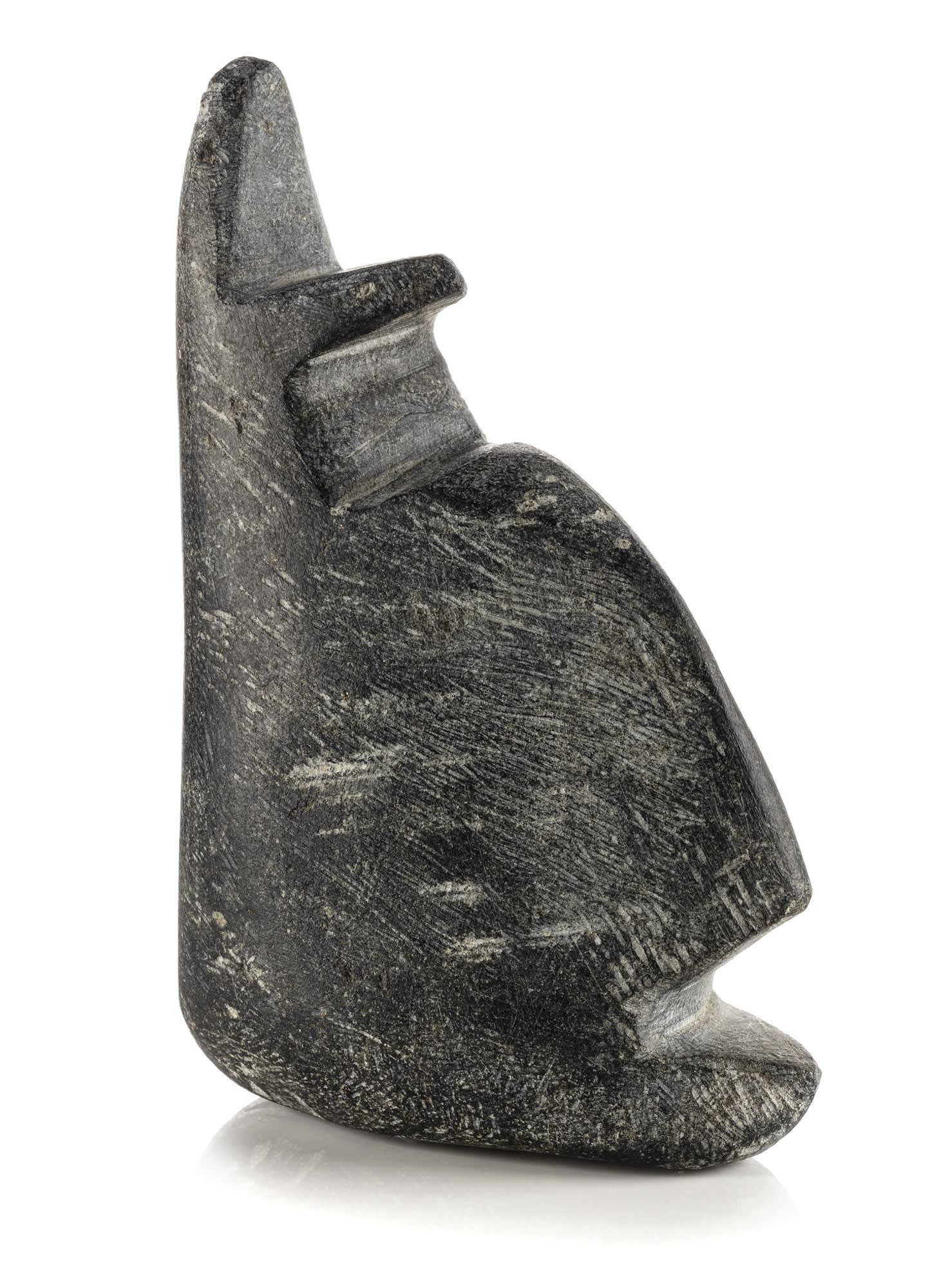
Lot 6
ANDY MIKI (1918-1983) ARVIAT (ESKIMO POINT)
Arctic Hare, c. 1972-74
Collection of John and Joyce Price, Seattle.
ESTIMATE: $3,000 — $5,000
While it is often impossible to identify many of Andy Miki’s small, semi-abstract carvings of animals by species, we are quite sure that this fine sculpture represents an Arctic hare. Although it presents a striking profile view, unlike the artist’s almost two-dimensional “cookie-cutter” pieces, Arctic Hare is robustly carved and decisively shaped into an almost prow-like front edge. The sculpture is positively imposing in its almost regal posture and in the sheer physicality of its textures. The work is small enough to fit in one’s hands; on display, however, it commands the space around it. Impressive and delightful.

Lot 134
ANDY MIKI (1918-1983) ARVIAT (ESKIMO POINT)
Resting Bird, c. 1968-70
Norman Zepp & Judith Varga Collection, Saskatoon.
ESTIMATE: $1,800 — $2,800
While many of Miki’s depictions of fauna are abstracted almost to the point where identification of species is difficult if not impossible, his sculptures of birds seem to be the exception to the rule. This wonderful Resting Bird is a nice counterpoint to his Bird in Flight from our July 2020 sale (Lot 3). Rather than depicted with wings extended, this charming creature is shown in comfortable repose. These two works, along with Animal from c. 1969 (see Zepp, Pure Vision, cat. 9) feature pedestal-like bases which are seamlessly integrated into the composition. There is a purity of line in Resting Bird that gives the sculpture a sense of casual elegance.

Lot 18
JOHN PANGNARK (1920-1980) ARVIAT (ESKIMO POINT)
Woman With Raised Arms, c. 1970-72
Collection of John and Joyce Price, Seattle.
ESTIMATE: $8,000 — $12,000
Woman with Raised Arms is an important transitional work from Pangnark’s “middle” period, dating from the very early 1970s; in other words, carved after the artist’s early experimentation with small, relatively naturalistic but hard-edged works in the late 1960s, and before the period when he delved into more extreme abstraction c. 1973-74. Quite a sizable work, this sculpture is carved in a dense, obdurate stone. The highly distinctive tool marks suggest that Pangnark worked very hard to coax a very expressive and even emotionally charged female figure from the stubborn material. The kneeling woman looks up and raises her arms in a gesture that might be beseeching or anguished or is possibly one of thanksgiving. Pangnark in fact carved several figures with raised arms over the course of his career (see references online). This imposing sculpture, slightly raw in both its physicality and emotional intensity, is one of the most impressive and moving examples we have seen.

Lot 82
JOHN PANGNARK (1920-1980) ARVIAT (ESKIMO POINT)
Figure Holding an Implement, c. 1972
Collection of Mr. Stanley and Mrs. Jean Zazelenchuk, New Brunswick.
ESTIMATE: $8,000 — $12,000
Figures by Pangnark with any sort of attachment are extremely rare. In fact, the only other example that comes to mind is Figure with Amulet, dated 1976 but likely carved somewhat earlier, exhibited in the 1985 Winnipeg Art Gallery show Uumajut: Animal Imagery in Inuit Art. In that sculpture the ivory amulet is almost certainly in the form of a bear’s head. In our example the antler accessory is more amorphous in shape, club-like rather than knife-like. While its use or meaning remains enigmatic, the figure’s gesture is positively emphatic. The figure brandishes the object like a weapon; his minimalist facial features assume an almost malevolent intensity. Remarkable.
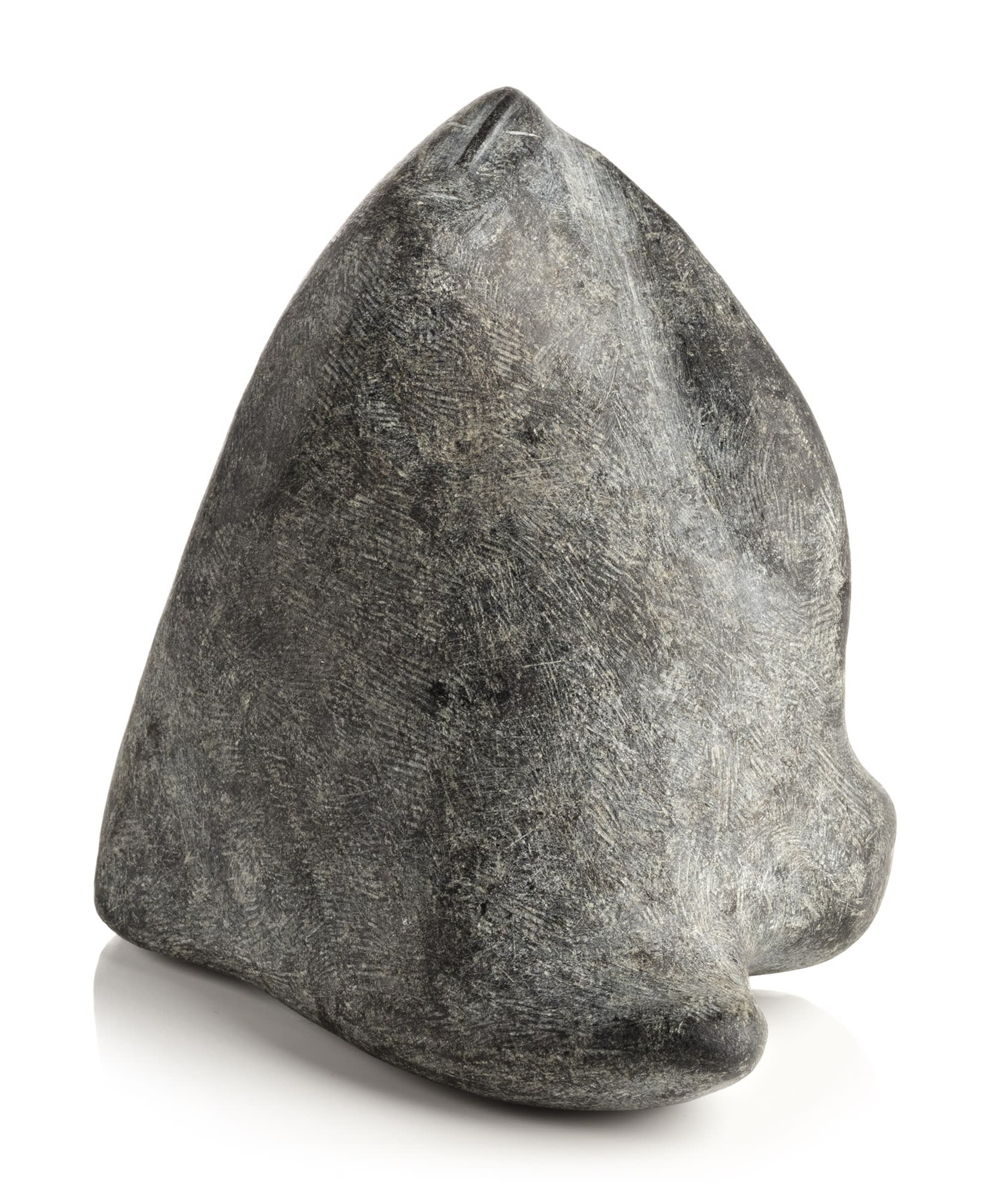
Lot 135
JOHN PANGNARK (1920-1980) ARVIAT (ESKIMO POINT)
Figure Looking Up, c. 1973-74
Private Collection, USA.
ESTIMATE: $1,200 — $1,800
John Pangnark’s distinctive style masterfully reduces the human figure to the bare, minimalist essentials. In Figure Looking Up the eyes, nose, and mouth are precisely etched and carved into the stone, while the gentle curves of the head, body, and limbs are merely suggested. The stone is patterned with delicate tool marks revealing the hand of the artist; we can almost feel Pangnark turning the piece this way and that, seeing and feeling every hill and hollow as the figure was being made. His earliest works already sit on the abstract side of the scale, but this charming example wanders happily further into the amorphous end of the spectrum. Dreamy and gorgeous.
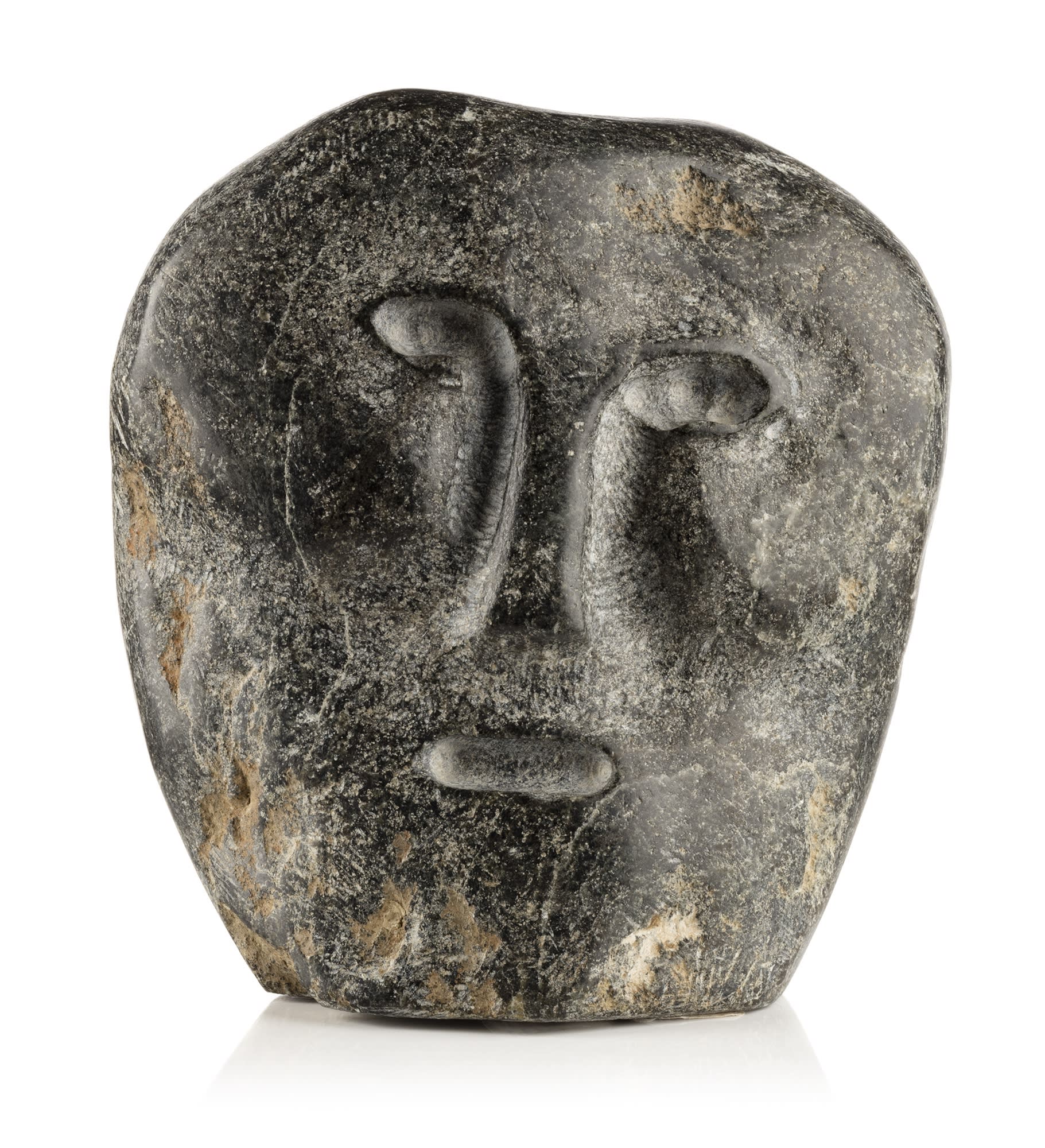

Lot 119
JOHN TIKTAK (1916-1981) KANGIQLIMIQ (RANKIN INLET)
Janus Head, c. 1975-76
Collection of Mr. Stanley and Mrs. Jean Zazelenchuk, New Brunswick.
ESTIMATE: $5,000 — $8,000
John Tiktak is deservedly famous for his superb figural sculptures: mothers and children, and single standing figures (see First Arts, 12 June 2023, Lot 58, and 14 June 2022, Lot 33 for two of several outstanding examples we have offered). Almost from the beginning, the figures’ expressive faces were often the focal points of these works. Tiktak began carving single heads in the mid 1960s, and multiple head works shortly thereafter; these became an important part of his repertoire (see First Arts, 5 Dec. 2022, Lot 127).
This remarkable Janus Head was carved near the end of Tiktak’s career in the mid 1970s (he almost never carved after the death of his wife Atangak c. 1975). By about 1970 Tiktak had begun using electric routers to create facial features. Consequently, many of these faces appear “gouged” rather than “carved” into the stone. Janus Head, although created from a hard stone and showing the marks of the router, is also shaped by hand with a high degree of sensitivity and is even polished to some extent. Rather than appearing brutal, the faces have a haunting quality and almost a fragility that belies the toughness of the stone. Perhaps they are portraits of Tiktak and his late wife.
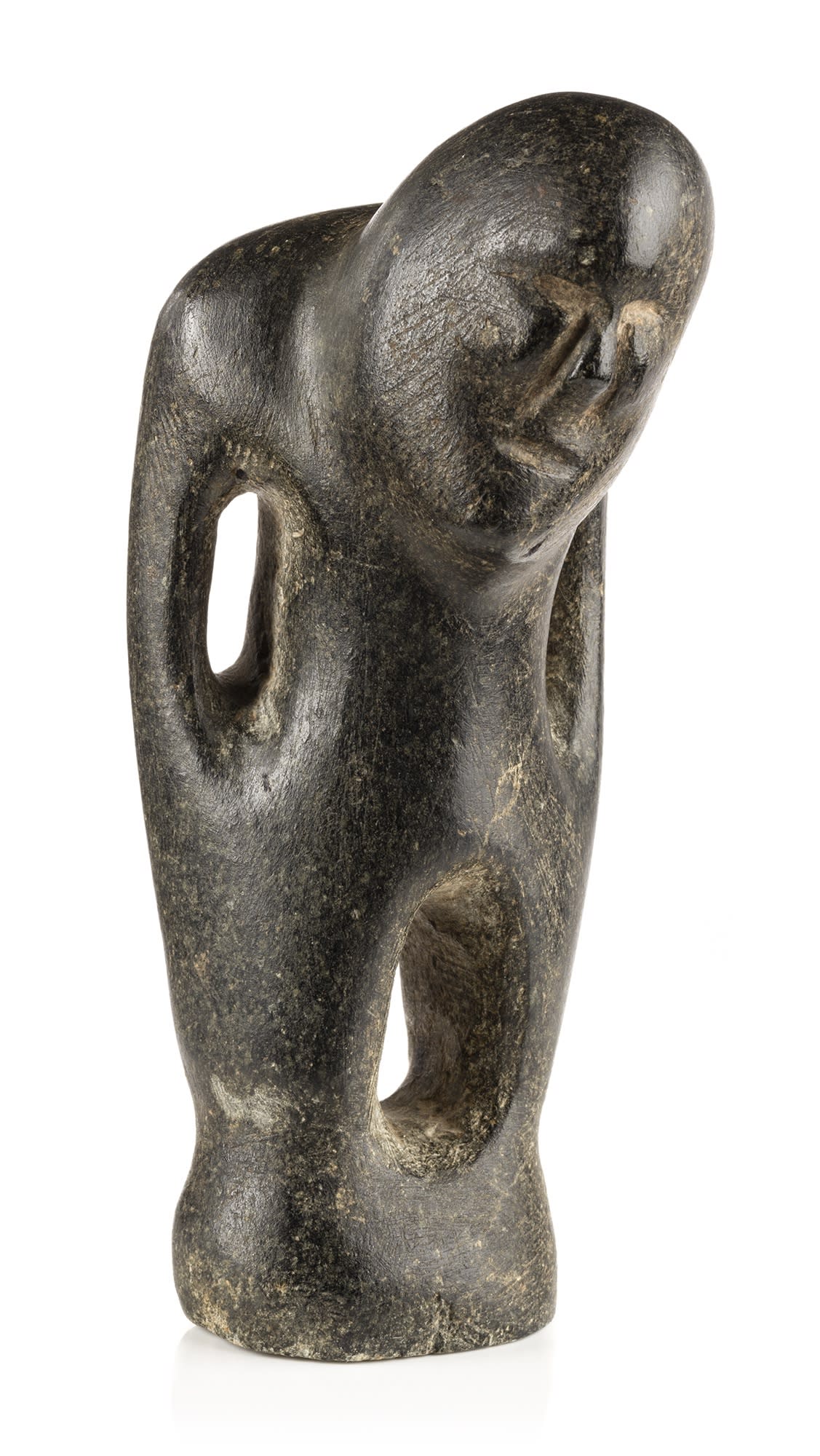
Lot 164
JOHN TIKTAK (1916-1981) KANGIQLIMIQ (RANKIN INLET)
Hunched Man, c. 1970-74
Acquired by a Private Collection, Saskatoon, gift of the artist; by descent in the family.
ESTIMATE: $6,000 — $9,000
This powerful little figure of a stooping man was presented by Tiktak to John G. McConnell, a professor of geography whose research took him to the region regularly during the late 1960s and early 1970s. McConnell had been introduced to the artist by his friend the anthropologist Robert Williamson, Tiktak’s neighbour, close friend, and enthusiastic supporter. Tiktak is reported to have stated that the carving represented an old man and jokingly claimed that it was a self-portrait. In our June 2022 sale (Lot 33) we featured a powerful yet whimsical whistling figure by the artist, noting that it showed Tiktak at his most human and charming. Hunched Man further shows us the range of emotions that Tiktak achieved with minimal means. The work displays similar humanity but with an added poignancy that is quite touching.
In a style typical of Tiktak’s later works, the subject is portrayed as a simplified, robust figure whose arms and legs are defined by three voids. (These hollows are Tiktak’s greatest invention and have led to many comparisons with the sculptures of Henry Moore.) What separates this figure from the majority of Tiktak’s oeuvre is the way the subject’s head seems to be weighed down by old age or fatigue. Although Tiktak was not particularly old when he created this piece, he was increasingly bothered by an old workplace injury he suffered at the Rankin Inlet nickel mine in 1959.
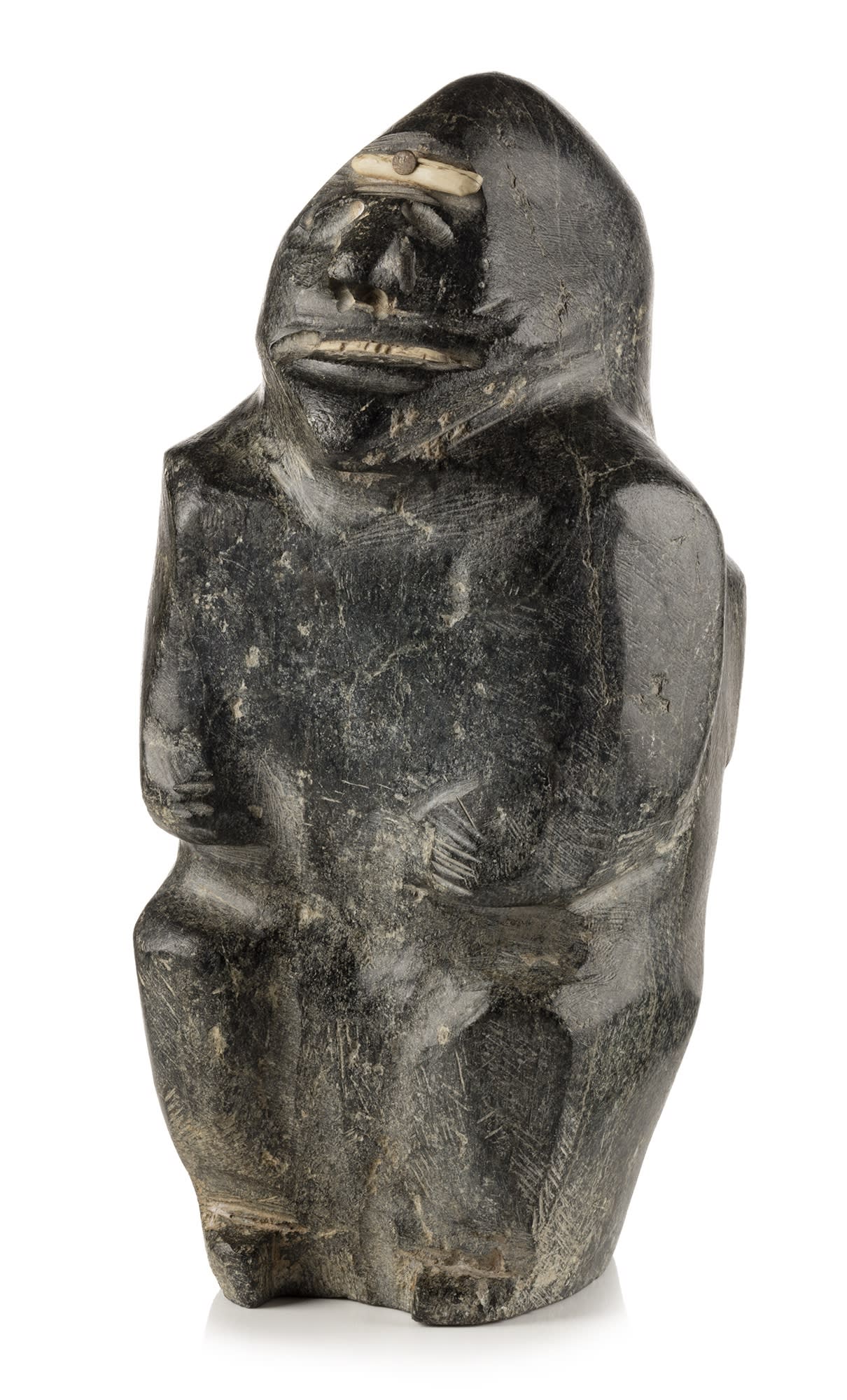
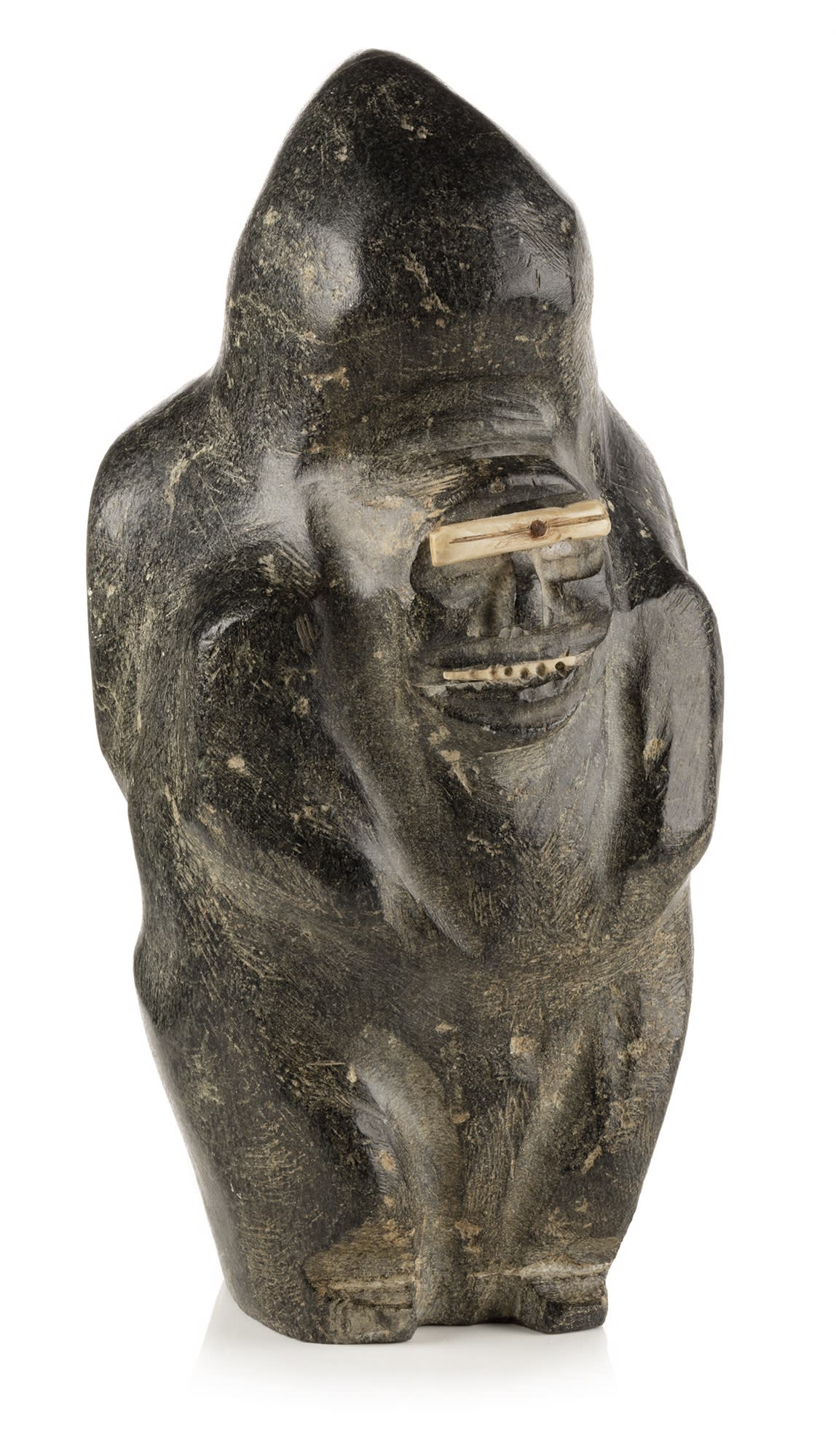
Lot 45
JOHN KAVIK (1897-1993) KANGIQLIMIQ (RANKIN INLET)
Father and Son Wearing Snow Goggles, c. 1960.
Collection of John and Joyce Price, Seattle.
ESTIMATE: $20,000 — $30,000
Born near Gjoa Haven in 1897, John Kavik lived for decades in the inland region between Baker Lake and Cambridge Bay before starvation forced his relocation in the late 1950s, first to Baker Lake then to Rankin Inlet in 1958. He found himself unfit to work at the local nickel mine, but instead of retiring he began carving in 1960; amazingly, Kavik continued making art until he was about ninety.
Kavik’s grit and determination are amply evident in his sculptures, which with few exceptions are notable for their starkness and raw energy. The term “crude” is often used to describe Kavik’s style – but stylistically, crudeness in a Kavik sculpture can encompass anything from the brutally elemental to the almost abstract, while emotionally and psychologically his works can express anything from terrifying bleakness to astonishing poignancy and even humour. Their common denominators are strength and honesty and vitality.
Father and Son Wearing Snow Goggles is an extraordinary work, even for Kavik. Importantly, it was carved at the very beginning of his long career, when Kavik was already an older man but still a “young” artist. The artist carved several back-to-back figures over the years; the best-known example, Double Figure from 1965, has been published in Norman Zepp’s Pure Vision (cat. 56); Swinton 1972/92 (fig. 646); and Sculpture/Inuit (cat. 386). Among his handful of figures or faces with snow goggles, the most famous example, Man Wearing Goggles from c. 1960 – a powerful masterpiece contemporaneous with this work – is published in Pure Vision (cat. 53) and elsewhere. Works by Kavik with inset or added antler are, however, exceedingly rare; we know of only one example, also contemporaneous with the present work (sold at Waddington’s in 1982). Unusually, Father and Son Wearing Snow Goggles combines all three elements, but what makes the sculpture truly exceptional is its monumentality, the rawness of its manufacture, and the expressionistic, starkly bleak portrayal of the two figures. The image is more than unsettling, it is positively gut-wrenching. We are simply gobsmacked by the power of this work, one of Kavik’s greatest masterpieces.

Lot 69
ELIZABETH NUTARAALUK AULATJUK (1914-1998) ARVIAT (ESKIMO POINT)
Mother and Two Children, early 1980s
Collection of John and Joyce Price, Seattle.
ESTIMATE: $8,000 — $12,000
Although Elizabeth Nutaraaluk, passionately devoted to her family, carved figures of mothers and children almost exclusively, Mother and Two Children is unusual in that it includes two children (or grandchildren) rather than the usual one. The evolution of the artist’s carving style is evident when we compare this powerful sculpture to a similarly themed work dated 1974 (see First Arts, 12 June 2023, Lot 29). The works share a similar size and monumentality, but the present example shows Nutaraaluk’s increasing tendency to follow the shape of the stone and to abstract or otherwise simplify the figures. Here is the rugged style she is best remembered for: a primal rawness that one could compare to the work of John Kavik from Rankin Inlet but perhaps more emotionally charged because of its content. Also highly distinctive are Nutaraaluk’s trademark hatch marks defining braids and hands.
Originally from the inland Ahiarmiut (Caribou Inuit) camp at Kitigaq (Ennadai Lake), Nutaraaluk’s family was forcibly relocated several times in the 1950s and finally settled in Arviat in the early 1960s. One of the first in the community to take up carving, Nutaraaluk became one of Arviat’s most important sculptors, working until weakness and blindness ended her career in the early 1990s.
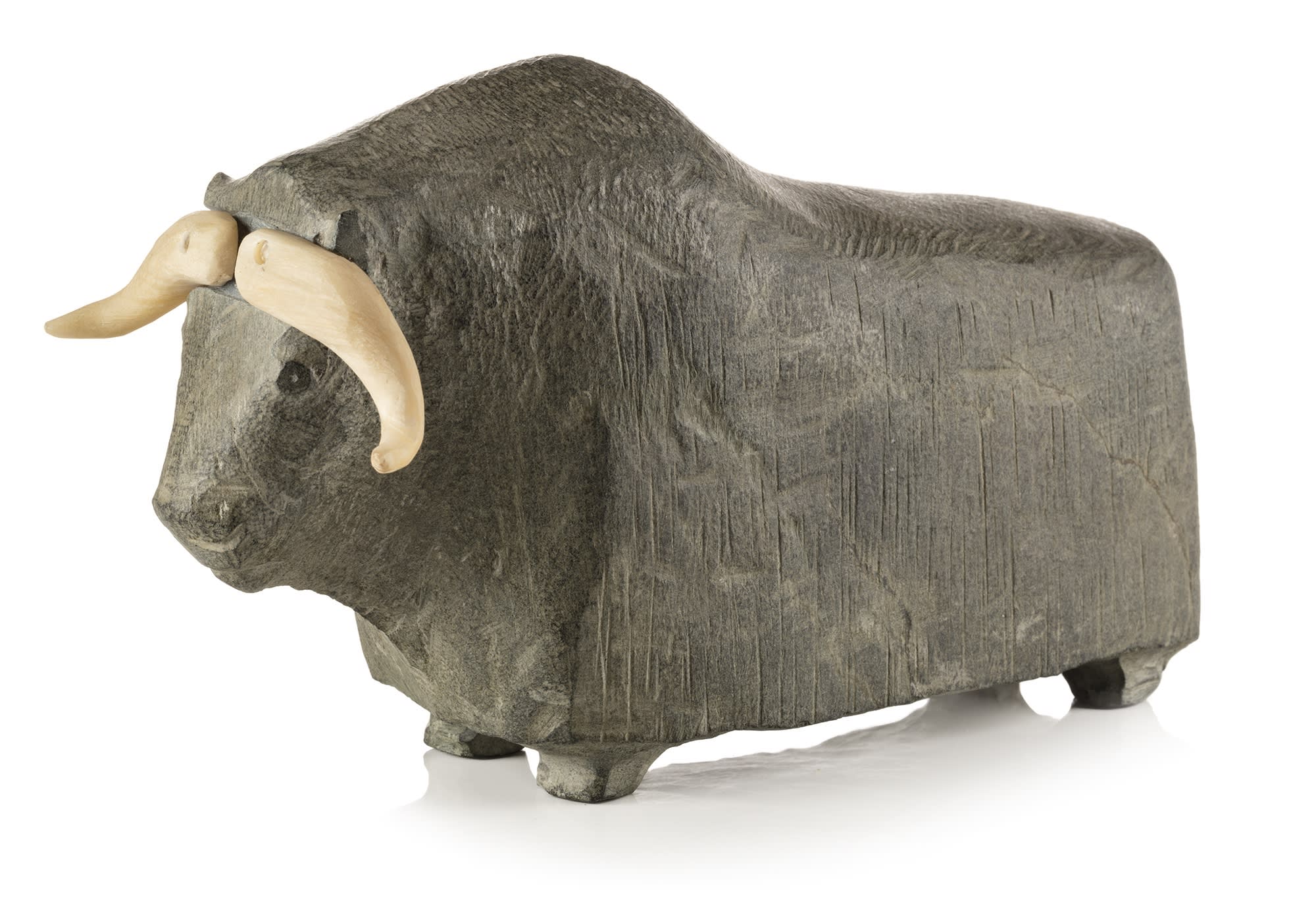
Lot 165
GEORGE TATANNIQ (1910-1991) QAMANI'TUAQ (BAKER LAKE)
Mouskox, c.1977
Norman Zepp & Judith Varga Collection, Saskatoon.
ESTIMATE: $4,000 — $6,000
The muskox was a subject that Tatanniq would revisit frequently over a period of two decades and it is interesting to look at the evolution of their design. Tatanniq’s muskoxen from the early 1960s are rather tall and svelte, perched atop almost delicate legs. As he moved into the 1970s, Tatanniq began making muskoxen that were often shorter and more stout and solid. And whereas his earlier beasts were usually given a smooth finish, the ‘70s sculptures paid greater attention to the long coarse guard hairs that make the muskox such a visually striking animal. In other words, the artist moved from semi-abstraction to a greater naturalism. In this fine example we see an animal standing at rest on a calm day. The almost exclusively vertical striations of its coat confirm this, conveying to this charming beast an air of serenity and strength.
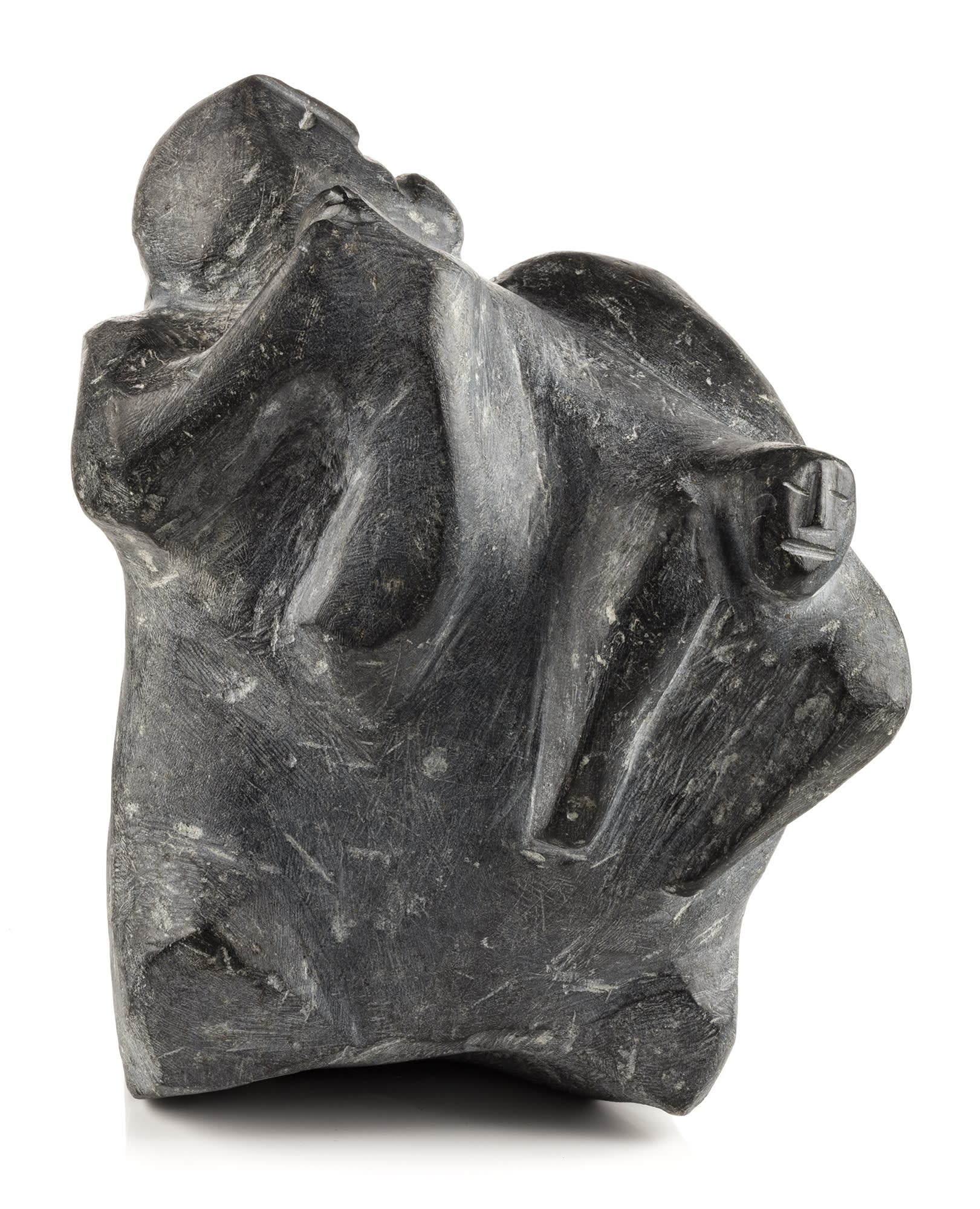
Lot 55
LUCY TASSEOR TUTSWEETOK (1934-2012) ARVIAT (ESKIMO POINT)
Mother with Two Children, 1980
Collection of John and Joyce Price, Seattle.
ESTIMATE: $10,000 — $15,000
In reviewing the literature on Lucy Tasseor, we feel that these thoughts seem particularly apt in describing how we feel about this sculpture, one of her greatest masterpieces.
“Something that remained consistent in Tasseor’s work right to the end of her career was a feeling of monumentality. Many works, especially larger ones, seem quite literally to be ‘monuments.’ Her sculptures, both the great ones and the more ordinary carvings, have a truly monolithic quality. Whether miniature or fist-sized or relatively large, they speak not only of family and community but also of hardness and resilience, of stone-ness. Instead of a frontispiece, the 1982 WAG catalogue Eskimo Point/Arviat offers this remarkable little poem by Tasseor:
My hands turn to stone
My feet turn to stone
I turn to stone
All of Me.” [1]
Mother and Two Children feels even more monumental than its already considerable size. The sculpture’s almost awesome strength derives partly from the large scale of the quite clearly defined figures themselves – especially that of the mother – but also from the powerful treatment of the forms. As we move around the work it truly feels as if it has been hewn out of a mountain. The great majority of Tasseor’s works depict multiple heads and faces; only some of her earliest works are what we would think of as truly figural; many late works show one or two individuals, but in very low relief. In Mother and Two Children, we feel the fortitude (and perhaps the frustration) of a mother who struggles to hold on to her rambunctious children. The solidity – the “stone-ness” – of the work is thus countered by the equally powerful forces of vitality and humanity. Although Tasseor’s work is most often compared to Pangnark’s, here we would suggest a closer affinity to the work of Elizabeth Nutaraaluk (Lot 69). A stupendous achievement.
1. Ingo Hessel, “I Turn to Stone” in Lucy Tasseor: I Turn to Stone (Toronto: Feheley Fine Arts, 2015), exhibition catalogue. Poem originally published in Bernadette Driscoll, Eskimo Point/Arviat (Winnipeg: Winnipeg Art Gallery), 1982.
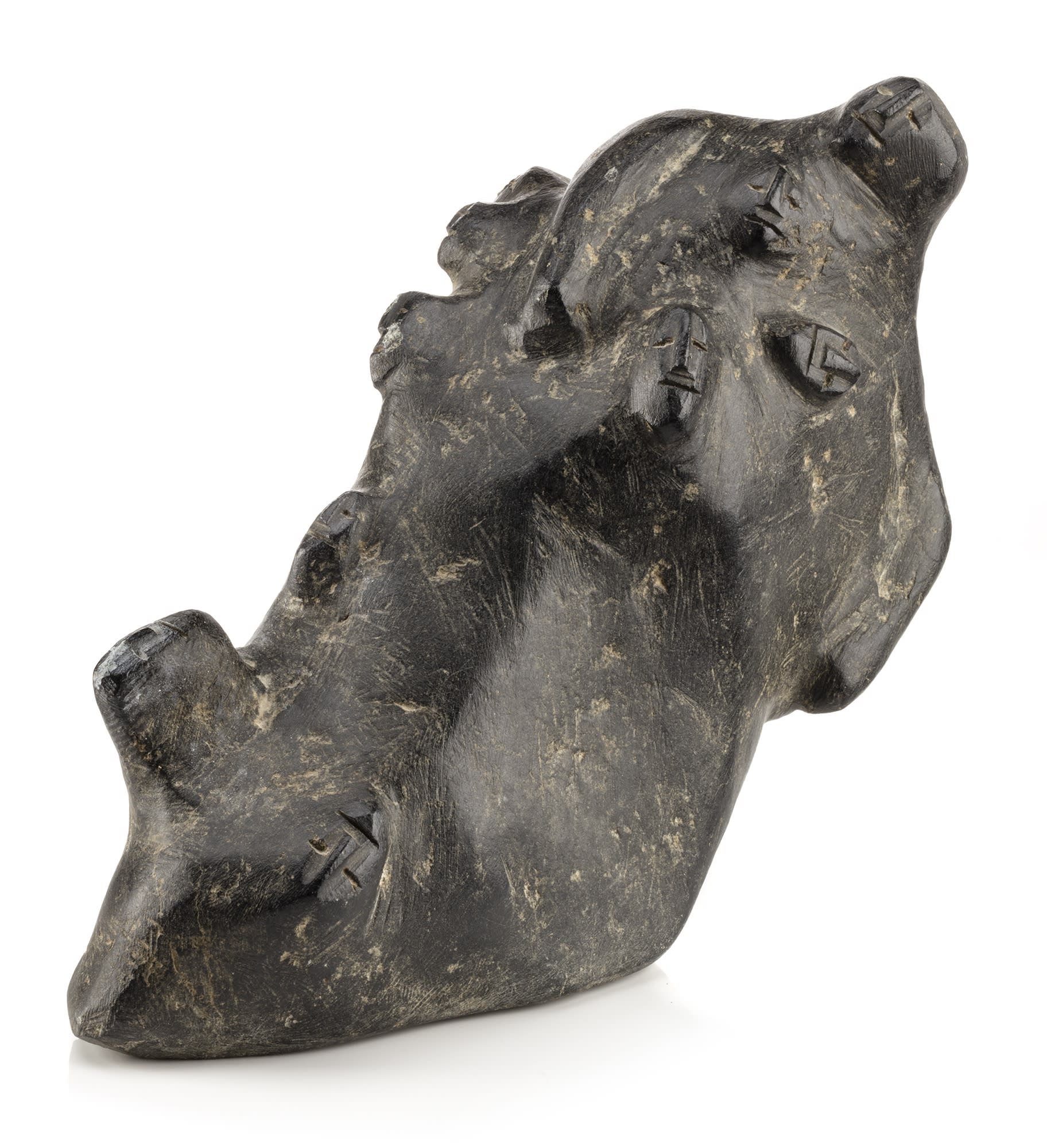
Lot 88
LUCY TASSEOR TUTSWEETOK (1934-2012) ARVIAT (ESKIMO POINT)
Family Group, c. mid-late 1970s
Norman Zepp & Judith Varga Collection, Saskatoon.
ESTIMATE: $7,000 — $10,000
This beautiful example of Tasseor’s classic mature style from the mid-late 1970s perfectly illustrates her willingness to follow the natural shape of the stone and to place the heads and faces of her subjects – a mother and her children – seemingly at random. But of course, they are not “randomly” placed; rather the children cluster mostly around the dominant figure of the mother, though it seems that several of the more adventurous ones have strayed quite far from her embrace. It’s a charming composition, full of movement and energized by the angularity of the stone. That odd tilt together with the boisterous nature of the children and the almost precarious slant of the mother’s body bring to mind the old nursery rhyme “There was an old woman who lived in a shoe…”!

Lot 133
LUCY TASSEOR TUTSWEETOK (1934-2012) ARVIAT (ESKIMO POINT)
Family, c. 1980-1982
An Ottawa Collection.
ESTIMATE: $10,000 — $15,000
At first I was carving seals and polar bears and not people. I did this three times and each time they were rejected. Finally, when I proceeded to carve again, I sat still for a long time. Suddenly a thought occurred to me and I remembered the words my grandfather Ulibbaq Isumatarjuaq told me on one of our hunting trips. Possibly with thoughts in his mind, he started to form something out of sand and began placing stones around it. I took that imagination and applied it to carving. (In Mark Kalluak in Pelts to Stone, 1993)
All we can say is thank goodness that Lucy Tasseor’s bears and seals were rejected. She presumably began carving c. 1965 when she and her husband Richard Tutsweetok moved to Arviat from Rankin Inlet. By 1967 she was carving lovely single figures, mothers and children, and the clusters of heads and faces for which she is renowned; five pieces by her were chosen for the famous Sculpture/Inuit exhibition that traveled the world in 1971-73 (and five by her friend Pangnark).
Family dates from the ten-year period 1975-1985, during which she produced most of her larger sculptures and several of her masterpieces, including Mother with Two Children and Family Group (this auction, Lots 55 and 88). In some cases, dynamic strength is derived from the interplay of relatively few and relatively naturalistic figures. Family attains its sense of power through the palpable sense of frenetic movement and energy as the myriad heads and faces pull and strain to escape the confines of the fortress-like mountain of stone. We barely realize that one of these subjects must be the mother until we notice the small arms – but these are so wide apart that they become symbolic rather than functional. Impressive.

Lot 71
LUKE ANOWTALIK (1932-2006) ARVIAT (ESKIMO POINT)
Caribou and the People, mid-late 1990s
Collection of John and Joyce Price, Seattle.
ESTIMATE: $7,000 — $10,000
This large yet sensitively rendered work is dominated by the large caribou head and climbing human figure at the top, and also features three faces, another dynamic human figure and a dog below. The small number of subjects suggests that this image likely depicts a single Caribou Inuit family – presumably Anowtalik’s own – sustained or perhaps watched over by the most important animal in their lives. The graceful verticality of the composition lends this lovely sculpture an almost totemic quality.
The importance of caribou to Anowtalik’s Ahiarmiut clan (originally from the inland area surrounding Ennadai Lake) is an important aspect of Anowtalik’s art. The animals appear frequently in his sculptures and in his late-career drawings, and of course provide the raw material for his whimsical antler works. Family was Anowtalik’s favoured subject matter, an inclination he shared with his artist-wife Mary Ayaq (Akjar) and his mother-in-law Elizabeth Nutaraaluk (see Lot 69). For an important similar composition by Anowtalik see First Arts, 1 December 2020, Lot 128.
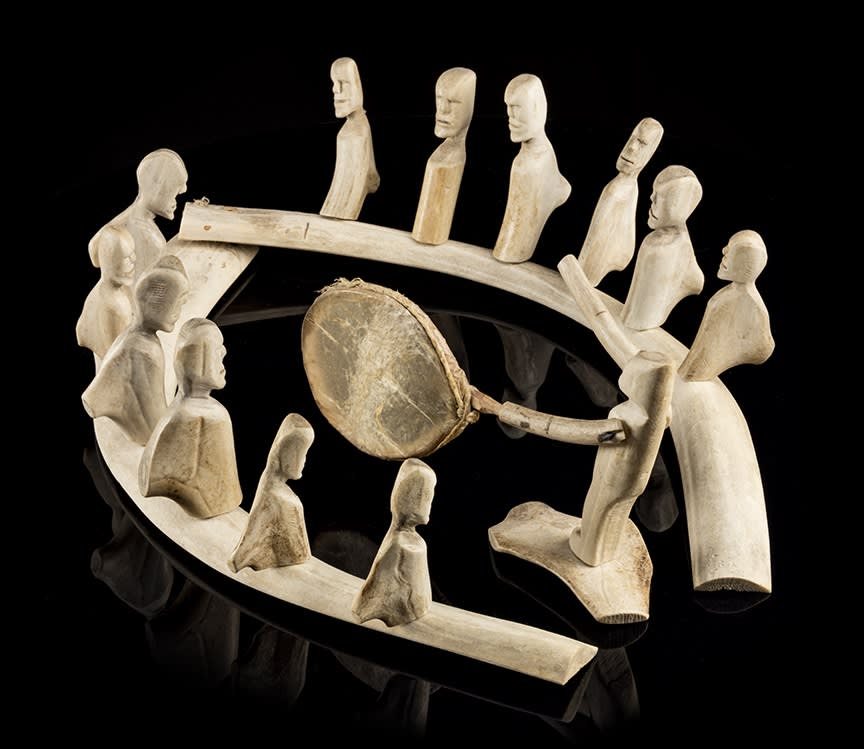
Lot 107
LUKE IKSIKTAARYUK (1909-1977) QAMANI'TUAQ (BAKER LAKE)
Drum Dance Scene, c. 1972
Norman Zepp & Judith Varga Collection, Saskatoon.
ESTIMATE: $20,000 — $30,000
Although many traditional Inuit drum dances were performed at important community events, festivals, and song contests, Iksiktaaryuk's drum dance scenes probably depict shamanic séances. (The artist’s other favourite subjects were single figures depicting standing or flying shamans.) These séances would have likely spiritually charged communal gatherings rather than festivities. As Jean Blodgett writes in The Coming and Going of the Shaman: "The solemnity of the performance, the absolute and evident trust and belief of the officiating shaman and his audience, and concerted singing of hymns and rhythmic beat of the drum all combined to give the séance the dignity of a religious service. [1] Drum dances were actively suppressed or discouraged by Christian missionaries, and while they went underground in some communities they essentially disappeared in others. Drum dancing has in recent decades undergone a revival but most performances, including those held in the South, are secular and festive in nature.
The standing drummer in this fine example is likely a shaman-drummer. He is encircled by a ring of seated or kneeling female a-ja-ja singers accompanying the hypnotic beat of the drum. (An unseen audience of men and women would have been seated or standing in a second, outer ring.) Iksiktaaryuk, who worked almost exclusively in caribou antler, makes sparing but effective use of the natural shapes of his chosen material. Particularly brilliant is his use of the natural protrusions of antler to represent the women’s amautiq pouches, which contrasts with the more upright and columnar figure of the drummer. The figure of the drummer is by necessity more complex, but minimally so. His left arm connects with the wooden drum handle, which is lashed to the wooden rim with sinew. As the focal point of the composition, the drum itself is fashioned with remarkable precision; amazingly, Iksiktaaryuk uses caribou heart tissue to approximate the relative thickness of a real drum’s scraped hide more closely. In contrast the right arm is treated minimally, with a simple groove indicating the beater extending from it. Another brilliant touch is the way the artist has split a single curved shaft of antler in two to create the lovely wishbone-shaped base for the singers.
Curator Norman Zepp chose Iksiktaaryuk as one of seven artists for his landmark Pure Vision exhibition. Zepp rightly sees these artists as having a “strength and purity of vision” that epitomizes the “minimalism” often seen in the art of the Keewatin [Kivalliq] Region; a “vitality and immediacy of expression common to art stripped of superfluous detail and reduced to its essential form.” [2] The spirit of Iksiktaaryuk's pared-down antler works contrasts with the more playful and "folk art" sensibility of other Inuit artists who have specialized in antler carving. For very similar examples of drum dances by the artist see Pure Vision, cat. 79, p. 136; and Jean Blodgett, Grasp Tight the Old Ways (Toronto: AGO, 1983), cat. 12, p. 47.
1. Jean Blodgett, The Coming and Going of the Shaman: Eskimo Shamanism and Art (Winnipeg Art Gallery, 1978), p. 140.
2. Norman Zepp, Pure Vision: The Keewatin Spirit (Regina: Norman Mackenzie Art Gallery, 1986), p. 35. See the section on the artist, pp. 130-139.
Comments
Nadine's provided such a vast amount of insight/education to this genre, of which so many of us are forever smitten. To Nadine & the Team at First Arts : I laud you copiously & with great appreciation for this brilliantly presented narrative. Magna cum laude !
